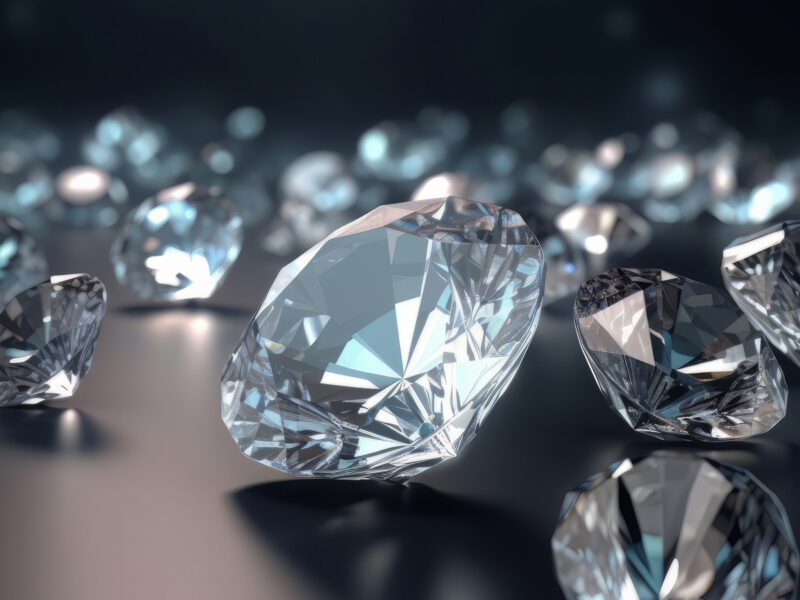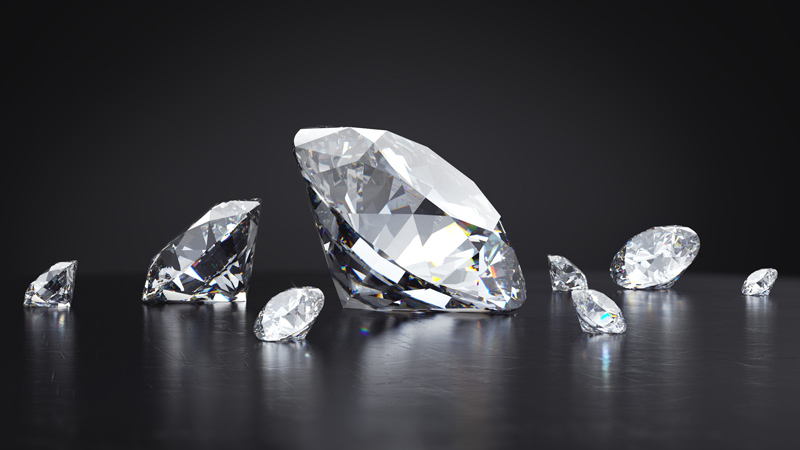
Featured Brand: Rolex
Rolex Dive Watches: Legends of the Deep
There's something undeniably cool about strapping on a dive watch. They're not just …
Read more
When a diamond catches your eye, what’s the first thing that captivates you? The sparkle, right? The secret behind that twinkle is one critical factor: diamond cut.
Among the four Cs – carat, colour, clarity, and cut – that define a diamond’s worth, it’s the cut that holds the most importance in shaping a diamond’s overall beauty and value.
Curious about how the cut of a diamond determines its appeal above all the other four “Cs”? Dive into this intriguing topic below!
Many people mistake “cut” for “shape”, but a diamond cut is a style guide that focuses on the symmetry, proportioning, and polishing of a diamond.
The cut is all about the placement of tiny flat surfaces, called facets, on the diamond. Depending on how they’re set, these facets can change the diamond’s shape and how it plays with light. That’s where the wow factor comes in – the sparkle and brilliance you can’t take your eyes off.
Diamond shape is about the outward appearance – the actual form of the diamond itself. Think round, cushion, and pear-shaped diamonds. This is how the diamond is shaped after it’s been cut.
Diamond cut is about the quality of the diamond and how it handles light. It’s not the shape but the facets, symmetry, and dimensions. A well-cut diamond sparkles brilliantly, while a poorly cut one looks dull.

The quality of a diamond’s cut is determined by a blend of various elements, like proportions, symmetry, brilliance and finishing touches. The better these aspects come together, the higher the diamond’s quality and price.
This refers to how the diamond is put together, including the crown, pavilion, and facets. When the proportions are just right, light smoothly enters and exits through the top. If the diamond’s proportions are off, too shallow or too deep, light escapes through the sides or bottom, and the diamond loses its sparkles.
Facets are like tiny mirrors that bounce light to your eyes. The size, placement, and symmetry of these facets affect how the diamond reflects light. If the facets aren’t perfect – too many or too few – the diamond won’t shine brilliantly.
Fire refers to the colourful light that dances off the diamond’s facets. A well-cut diamond has both brightness and fire. When you look at the diamond, especially in daylight, you should see colourful flashes.
Brilliance refers to how bright the diamond looks. A quality diamond cut should reflect lots of white light. If the cut is wrong, uneven, too deep or too shallow, it appears dull.
Scintillation refers to the sparkles you see when light moves across the diamond’s surface. More scintillation means more sparkles, making it more appealing.
Polishing concerns how well the diamond cutter finished the stone to achieve a glass-like appearance. Most diamonds have some degree of polish flaws, which you won’t spot without intense magnification.
Finishing details are the final brushstrokes that make the diamond truly shine, figuratively and literally. These details encompass the craftsmanship, including any permanent treatments and polishing.
| Excellent | The highest grade for diamond cut; it exhibits the highest level of brilliance and fire. Almost all incoming light is reflected through the table, creating magnificent sparkle and radiance. |
|---|---|
| Very Good | These diamonds exhibit high brilliance and scintillation. However, they may appear slightly darker in the centre or around the edges. To the naked eye, Very Good cut diamonds provide a sparkle similar to those with an Excellent grade. |
| Good | These diamonds appear somewhat darker or lack scintillation. However, it still creates a beautiful sparkle at a more affordable price point. |
| Fair | Diamonds in this category will exhibit minimal brilliance and scintillation. Fair-cut diamonds may be suitable for smaller carats or when used as side stones. |
| Poor | Poor cut diamonds have significantly poor proportions and lack sparkle, brilliance and fire. You can expect to see characteristics like “nail heads” (a black centre) and “fish eyes” (complete loss of brilliance in the centre). |
Before we delve into the types, let’s look at the cut quality – not to be mistaken with cut grade.

| Ideal cut | This is the gold standard of diamond brilliance. An ideal cut boasts excellent polish and flawless symmetry and captures almost all light that enters it. |
|---|---|
| Shallow cut | When a diamond is cut too shallow, it doesn’t sparkle as brilliantly. These diamonds, often called “spread”, lack depth compared to ideal cuts. Most of the light that enters escapes from the bottom, leading to a lacklustre appearance. |
| Deep cut | When a diamond is cut too deep, it traps the light. The light hits the pavilion (top) at a sharper angle and is forced to pass through the bottom of the diamond. The result is less sparkle and liveliness, and lower brightness. |
The brilliant diamond cut is a classic. It features triangular and kite-shaped facets that radiate out from the centre of the diamond. When they catch the light, they create a dazzling display, almost like a sparkling prism.
Round brilliant diamonds, like in this diamond tennis bracelet, take the cake, but the cushion, marquise, pear, and oval-shaped diamond cuts are also popular brilliant cuts. Although, none does the brilliant cut better than the classic round diamond!
Imagine a set of elegant stairs, each step made of rectangular facets. That’s the step cut. These facets vary in size, ascending in size outwards and descending downwards. When light bounces off, it creates a unique, mirrored effect.
The most popular step cut is the emerald cut, but other equally beautiful step cut diamonds are the Asscher cut and baguette cut.
Just as the name suggests, mixed cuts are a blend of brilliant and step cut facets. They give off a distinctive, crushed ice appearance when they catch the light. You’ll mostly find mixed cut diamonds in fancy-shaped diamonds such as cushion, radiant, princess or pear cut, like in this beautiful Emerald necklace with pear cut diamonds.
From the tip to the top, understanding diamond anatomy and the terms that go along with it is key to knowing the quality of this precious gem.

| Table | The table, the diamond’s largest facet, is the flat top. It’s the primary entry and exit point for light, responsible for the diamond’s sparkle. The table’s size affects the diamond’s light intake and overall performance. |
|---|---|
| Crown | A diamond’s crown is the uppermost section of the stone. The size and angle of these facets matter as a shallow crown angle results in brilliance but no fire and a steep angle offers fire but lacks brilliance. |
| Girdle | The girdle acts as a border between the upper crown and lower pavilion. Despite its small size, it’s essential. A too-thin girdle can be fragile, while a too-thick girdle adds weight without size. |
| Pavilion | Below the girdle lies the pavilion, often seen as the noticeable “V” shape of the base of the diamond. It reflects light back through the crown to the viewer, enhancing the diamond’s beauty. |
| Culet | The culet is a facet at the very tip of the diamond, designed to protect it from splitting or chipping. It adds durability and can also contribute to brilliance and refraction. |
Regardless of colour, clarity, or carat weight, the cut is what truly determines the stone’s allure. A poorly cut diamond will appear dull, while a well-cut diamond will sparkle with fire and brilliance.
If you’re shopping for that perfect diamond engagement ring or exquisite diamond jewellery, prioritise a high-cut grade. A superior cut allows you to compromise slightly on colour and clarity without sacrificing the diamond’s overall appeal.
For a stunning and quality diamond, choose an excellent cut, particularly for round brilliant cut diamonds. However, always be sure to select reputable jewellers and dealers while shopping.
Surprisingly, there is a definite answer to this. The diamond cut that sparkles the most is the round brilliant diamond cut. A round brilliant cut diamond boasts 58 facets that create a dazzling sparkle when the light hits it. A princess-cut diamond is considered the second most sparkly.
The round brilliant cut is the costliest among diamond cuts, and it’s also the most favoured for engagement rings. Its high price is because it boasts the highest number of facets, demanding exceptional precision during the cutting process.
In the world of diamonds, cut holds the most important role. It’s the magic that turns rough stones into dazzling gems, creating brilliance and sparkle.
When you’re choosing your diamond jewellery, remember that a superior cut is the key to its beauty – don’t overlook it. Choose wisely, and your diamond will always shine bright!

Featured Brand: Rolex
There's something undeniably cool about strapping on a dive watch. They're not just …
Read more
Featured Brand: Hermès
Described as practical, stylish, and highly desirable, the Hermès Birkin bag has …
Read more
Featured Brand: Hermès
In the world of high fashion and demand, few names command as much attention as …
Read more
Featured Brand: Patek Philippe
In the world of high-end luxury watches, there's one name that consistently stands …
Read moreMayfair’s finest collectable jewellery and watch retailer - Book an appointment
Shop
About Global Boutique
Global Boutique
13 South Molton Street,
Mayfair, London, W1K 5QW,
United Kingdom
Telephone:
0800 069 9323
Email:
enquiries@globalboutique.com
Sign up for our newsletter
Receive exclusive news from Global Boutique, including product releases and updates
© 2026 Global Mayfair Boutique Ltd - all rights reserved
Registered Office: 27 Mortimer Street, London, W1T 3BL, United Kingdom.
Registered in England and Wales, Company number 13680049. Registered VAT Number GB 396600769.
We’ll share helpful and informative information about watches and more from the luxury world, as well as our newest arrivals, and special events.
* We promise not to overload your inbox, and to never sell or share your information. Unsubscribing is easy.
